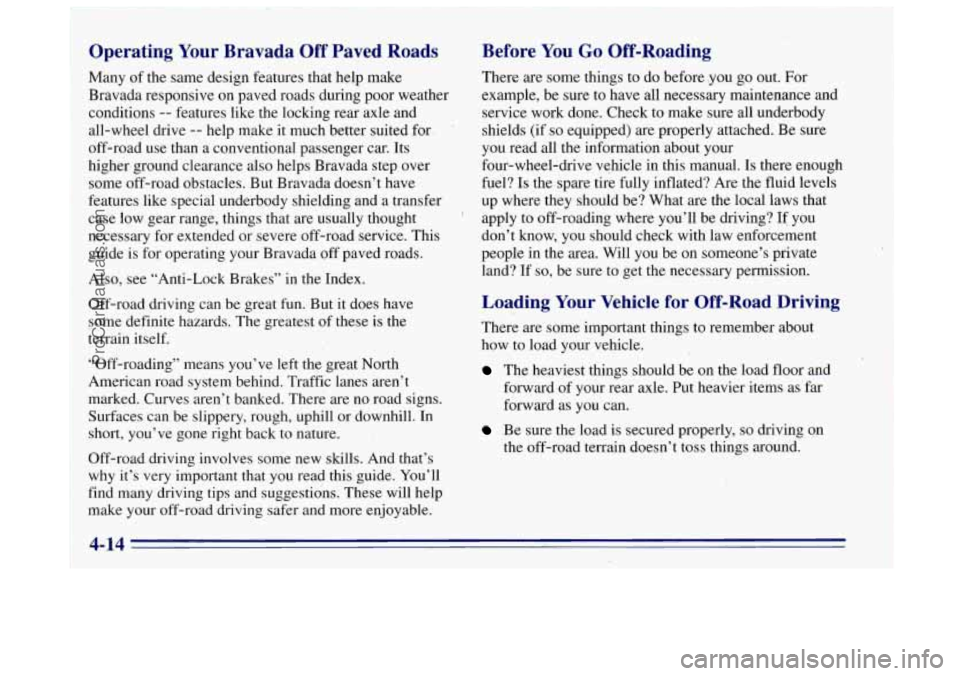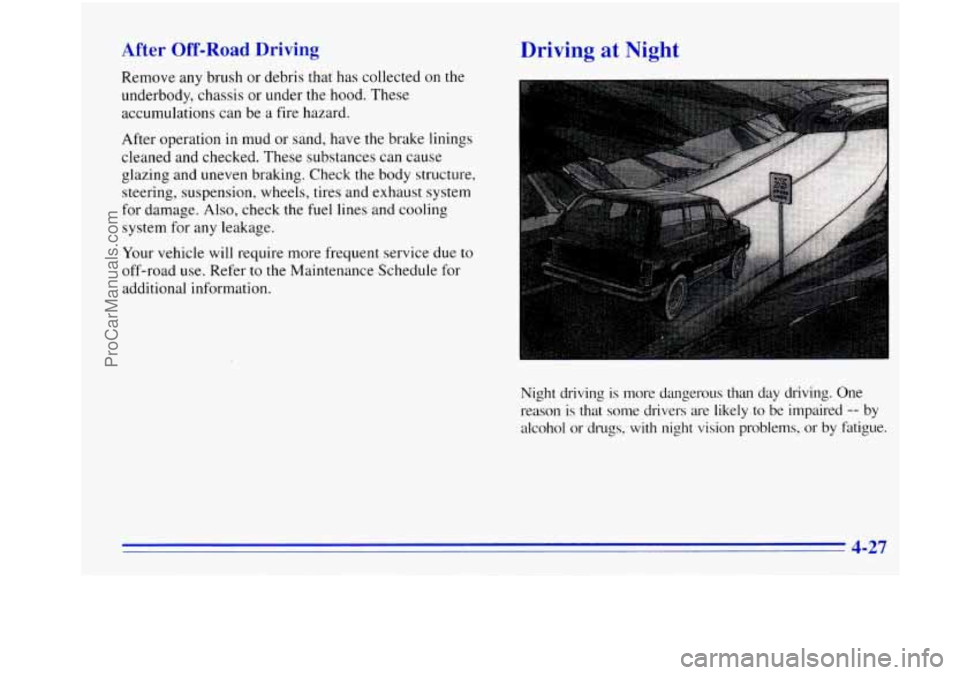1996 OLDSMOBILE BRAVADA maintenance
[x] Cancel search: maintenancePage 3 of 340

The 1996 Oldsrnobile Bravada Owner’s Manual
Seats and Restraint Systems ............................................................. 1-1
Features and Controls .................................................................. 2-1
Comfort Controls and Audio Systems ..................................................... 3-1
This section tells you how to use your seats and safety belts\
properly. It also explains the “SIR” system.
This section explains how to start and operate your Oldsmobile.
This section tells you how to adjust the ventilation and comfort controls and how to operate your
audio system.
Here you’ll find helpful information and tips about
the road and how to drive under different conditions.
This section tells you what
to do if you have a problem while driving, such as a flat tire or
overheated engine, etc.
Here the manual
tells you how to keep your Oldsmobile running properly and looking good.
This section tells
you when to perform vehicle maintenance and what fluids and lubricants to use.
This section tells you how
to contact Oldsmobile for assistance and how to get service and owner publications.
It
also gives you information on “Reporting Safety Defects” on pag\
e 8-7.
YourDrivingandtheRoad .............................................................. 4-1
ProblemsontheRoad .................................................................. 5-1
ServiceandAppearanceCare ............................................................ 6-1
Maintenanceschedule .................................................................. 7-1
Customer Assistance Information ........................................................ 8-1
Index ........................................................................\
........ 9-1
Here’s an alphabetical listing of almost every subject in this manual. You can use it to quickly find
something you want to read.
i
ProCarManuals.com
Page 29 of 340

Servicing Your Air Bag-Equipped
Oldsmobile
The air bag affects how your Oldsmobile should be
serviced. There are parts
of the air bag system in several
places around your vehicle. You don’t want the system
to inflate while someone is working on your vehicle.
Your Oldsmobile retailer and the Bravada Service
Manual have information about servicing your vehicle
and the air bag system.
To purchase a service manual,
see “Service and Owner Publications”
in the Index.
A CAUTION:
-
For up to two minutes after the ignition key is
turned off and the battery is disconnected, an air
bag can still inflate during improper service. You
can be injured if you are close to an air bag when
it inflates. Avoid wires wrapped with yellow tape,
or yellow connectors. They are probably part of
the air bag system. Be sure to follow proper
service procedures, and make sure the person
performing work for you is qualified to do
so.
The air bag system does not need regular maintenance.
Adding Equipment to Your
Air Bag-Equipped Oldsmobile
If I add a push bumper or a bicycle rack to the
front of my vehicle, will it keep the air bag from
working properly?
A: As long as the push bumper or bicycle rack is
attached to your vehicle
so that the vehicle’s basic
structure isn’t changed, it’s not likely to keep
the
air bags from working properly in a crash.
Is there anything I might add to the front of the
vehicle that could keep the air bag from
working properly?
A: Yes. If you add things that change your vehicle’s
frame, bumper system, front end sheet metal or
height, they may keep the air bag system from working properly. Also,
the air bag system may not
work properly
if you relocate any of the air bag
sensors. If you have any question about this, you
should contact Customer Assistance before you
modify your vehicle. (The phone numbers and
addresses for Customer Assistance are
in Step Two of
the Customer Satisfxtion Procedure
in this manual.
See “Customer Satisfaction Procedure’’
in the Index.)
ProCarManuals.com
Page 50 of 340

Safety Belt Extender
If the vehicle’s safety belt will fasten around you, you
should use
it.
But if a safety belt isn’t long enough to fasten, your
retailer will order you an extender. It’s free. When you
go
in to order it, take the heaviest coat you will wear, so
the extender will be long enough for you. The extender
will be just for you, and just for the seat
in your vehicle
that you choose. Don’t let someone else use it, and use
it
only for the seat it is made to fit. To wear it, just attach it
to the regular safety belt.
Checking Your Restraint Systems
Now and then, make sure the safety belt reminder light
and all your belts, buckles, latch plates, retractors and
anchorages are working properly.
Look for any other
loose or damaged safety belt system parts. If you see
anything that might keep
a safety belt system from
doing its job, have
it repaired.
Torn or frayed safety belts may not protect
you in a
crash. They can rip apart under impact forces. If a belt is
torn or frayed, get a new one right away.
Also look for any opened or broken air bag covers, and
have them repaired or replaced.
(The air bag system
does not need regular maintenance.)
ProCarManuals.com
Page 142 of 340

Operating Your Bravada Off Paved Roads
Many of the s’ame design features that help make
Bravada responsive on paved roads during poor weather conditions
-- features like the locking rear axle and
all-wheel drive
-.- help make it much better suited for.
off-road use than a conventional passenger car. Its
higher.ground clearance also helps Bravada step over
some off-road obstacles. But Bravada doesn’t have
features like special underbody shielding and a transfer
case low gear range, things that are usually thought
necessary for extended or severe off-road service. This
guide is for operating your Bravada off paved roads.
Also, see “Anti-Lock Brakes” in the Index.
Off-road driving can be great fun. But it does have
I r some definite hazards. The greatest of these is the
’ terrain itself.
t
“Off-roading” means you’ve left the great North
marked. Curves aren’t banked. There are no road signs.
Surfaces can be slippery, rough, uphill or downhill. In
Off-road driving involves some new skills. And that’s
why it’s very important that you read this guide. You’ll
find many driving tips and suggestions. These will help
make your off-road driving safer and more enjoyable.
merican road system behind. Traffic lanes aren’t
hort, you’ve gone right back
to nature.
Before You Go Off-Roading
There are some things to do before ,you go out. For
example, be sure to have all necessary maintenance and
service work done. Check to make sure all underbody
shields (if
so equipped) are properly attached. Be sure
you read all the information about your
four-wheel-drive vehicle in this manual.
Is there enough
fuel? Is the spare tire fully inflated? Are the fluid levels
up where they should be? What are the local laws that
apply to off-roading where you’ll be driving?
If you
don’t
know, you should check with law enforcement
people in the area. Will you be on someone’s private
land? If
so, be sure to get the necessary permission.
Loading Your Vehicle for Off-Road Driving
There are some important things to remember about
how to load your vehicle.
The heaviest things should be on the load floor and
forward of your rear axle. Put heavier items as far
forward as you can.
Be sure the load is secured properly, so driving on
the off-road terrain doesn’t toss things around.
,
4-14
ProCarManuals.com
Page 155 of 340

After Off-Road Driving
Remove any brush or debris that has collected on the
underbody, chassis or under the hood. These
accumulations can be a fire hazard.
Driving at Night
After operation in mud or sand, have the brake linings
cleaned and checked. These substances can cause
glazing and uneven braking. Check the body structure,
steering, suspension, wheels, tires and exhaust system
for damage. Also, check the fuel lines and cooling
system for any leakage.
Your vehicle will require more frequent service due to
off-road use. Refer to the Maintenance Schedule for
additional information.
Night driving is more dangerous than day driving. One reason is that some drivers are
likely to be impaired -- by
alcohol or drugs, with night vision problems, or by fdtigue.
ProCarManuals.com
Page 179 of 340

When You Are Ready to Leave
After Parking on a Hill
1. Apply your regular brakes and hold the pedal down
while you:
Start your engine;
0 Shift into a gear; and
0 Release the parking brake.
2. Let up on the brake pedal.
3. Drive slowly until the trailer is clear of the chocks.
4. Stop and have someone pick up and store the chocks.
Maintenance When Trailer Towing
Your vehicle will need service more often when you’re
pulling a trailer. See the Maintenance Schedule for more
on this. Things that are especially important
in trailer
operation are automatic transmission fluid (don’t
overfill), engine
oil, axle lubricant, belt, cooling system
and brake adjustment. Each
of these is covered in this
manual, and the Index
will help you find them quickly.
If you’re trailering, it’s a good idea to review these
sections before you start your trip.
Check periodically to
see that all hitch nuts and
bolts are tight.
ProCarManuals.com
Page 214 of 340

Your vehicle has an air bag system. Before attempting to
do your own service work, see “Servicing Your Air
Bag-Equipped Oldsmobile” in the Index.
You should keep a record with all parts receipts and
list the mileage and the date of any service work
you
perform. See “Maintenance Record” in the Index.
You can be injured and your vehicle could be
damaged if you
try to do service work on a
vehicle without knowing enough about it.
0 Be sure you have sufficient knowledge,
experience, and the proper replacement
’
parts and tools before you attempt any
vehicle maintenance task.
Be sure to use the proper nuts, bolts and
other fasteners. “English” and “metric”
fasteners can be easily confused. If
you use
the wrong fasteners, parts can later break
or fall off. You could be hurt.
Fuel
Use regular unleaded gasoline rated at 87 octane or
higher. At a minimum,
it should meet specifications
ASTM D4814 in the United States and
CGSB 3.5-M93
in Canada. Improved gasoline specifications have been
developed by the American Automobile Manufacturers
Association (AAMA) for better vehicle performance
and engine protection. Gasolines meeting the AAMA
specification could provide improved driveability and
emission control system protection compared to
other gasolines.
Be sure the posted octane is at least 87.
If the octane is
less than 87, you may get a heavy knocking noise when
you drive.
If it’s bad enough, it can damage your engine.
If you’re using fuel rated at 87 octane or higher and you
still hear heavy knocking, your engine needs service.
But don’t worry
if you hear a little pinging noise when
you’re accelerating or driving up
a hill. That’s normal,
and you don’t have to buy a higher octane fuel to get rid
of pinging. It’s the heavy, constant knock that means
you have a problem.
6-2
ProCarManuals.com
Page 225 of 340

4ir Cleaner
To remove the air cleaner,
open both clamps and push
the rear of the air cleaner
toward the rear
of the
engine compartment.
Insert
a new filter. Then replace the air cleaner
assembly, making certain the
PVC air tube is properly
seated
in the left hand valve cover and the clamps are
securely fastened.
Refer to the Maintenance Schedule
to determine when to
replace the air filter.
See “Scheduled Maintenance Services”
in the Index.
I
Operating the engine with the air cleaner off
can cause you
or others to be burned. The air
cleaner not only cleans the air, it stops flame if
the engine backfires.
If it isn’t there, and the
engine backfires, you could be burned. Don’t
drive with it off, and be careful working on the
engine with the air cleaner off.
I NOTICE:
If the air cleaner is off, a backfire can cause a
damaging engine fire. And, dirt can easily get
into your engine, which will damage it. Always
have the air cleaner in place when you’re driving.
6-13
-
ProCarManuals.com